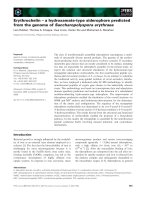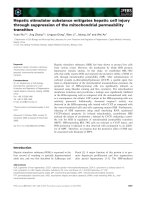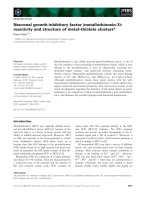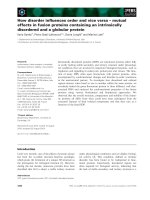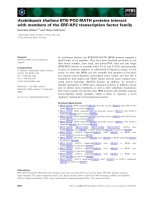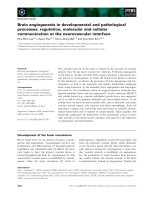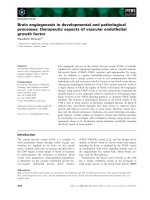Tài liệu Báo cáo khoa học: Emerging pathways in genetic Parkinson’s disease: Potential role of ceramide metabolism in Lewy body disease pptx
Bạn đang xem bản rút gọn của tài liệu. Xem và tải ngay bản đầy đủ của tài liệu tại đây (322.9 KB, 7 trang )
MINIREVIEW
Emerging pathways in genetic Parkinson’s disease:
Potential role of ceramide metabolism in Lewy body disease
Jose Bras
1,2
, Andrew Singleton
1
, Mark R. Cookson
3
and John Hardy
4,5
1 Molecular Genetics Unit, National Institutes on Aging, Bethesda, MD, USA
2 Center for Neuroscience and Cell Biology, University of Coimbra, Portugal
3 Cell Biology and Gene Expression Unit, National Institutes on Aging, Bethesda, MD, USA
4 Department of Molecular Neuroscience, Institute of Neurology, University College London, UK
5 Reta Lila Weston Institute and Department of Neurodegenerative Disease, Institute of Neurology, London, UK
Parkinson’s disease (PD) is a common neurodegenera-
tive disease which affects over 1% of people over the
age of 65 years [1]. Clinical manifestations include
bradykinesia, rigidity, tremor and postural instability.
From a pathological perspective, PD is characterized
by dopamine neuron degeneration, which leads to
depigmentation of the substantia nigra. In addition,
typical PD cases have intracellular proteinaceous inclu-
sions called Lewy bodies and Lewy neurites in the
brainstem and cortical areas.
Genetic research in the past decade has changed the
view of PD from an archetypical non-genetic disease
to one having a clear genetic basis in a percentage of
patients [2]. Five genes have been cloned in which
mutations cause parkinsonism in a mendelian fashion
[3–8] (Table 1).
Classically, the approach taken to the study of
genetic forms of PD has relied on a clinical definition
of disease and PARK loci have been assigned on this
clinical basis. It is known what clinical features are pri-
marily associated with each locus and a great deal of
attention has been focused on this association [9].
However, if one wants to identify pathways of patho-
genicity for a given disorder, arguably, one should
start by analyzing the genetics of disease based on
pathology. In this minireview, we start from the posi-
tion that it is more likely to find a common pathway if
there is a common pathology rather than common
clinical characteristics. We and others have suggested
that, for the early onset recessive diseases (encoded at
the parkin, PINK1 and DJ-1 loci), in which Lewy
bodies are either usually absent (parkin) or where no
Keywords
ceramide; gene; glucocerebrosidase; Lewy
body; loci; mutation; pathogenesis; pathway;
risk factor; susceptibility
Correspondence
J. Hardy, Department of Molecular
Neuroscience, Institute of Neurology,
University College London, Queen Square,
London WC1N 3BG, UK
Fax: +44-0207-833-1016
Tel: +44-0207-829-8722
E-mail:
(Received 7 July 2008, revised 2 September
2008, accepted 25 September 2008)
doi:10.1111/j.1742-4658.2008.06709.x
Heterozygous loss-of-function mutations at the glucosecerebrosidase locus
have recently been shown to be a potent risk factor for Lewy body disease.
Based on this observation, we have re-evaluated the likelihood that the dif-
ferent PARK loci (defined using clinical criteria for disease) may be
misleading attempts to find common pathways to pathogenesis. Rather, we
suggest, grouping the different loci which lead to different Lewy body
disease may be more revealing. Doing this, we suggest that several of the
genes involved in disparate Lewy body diseases impinge on ceramide
metabolism and we suggest that this may be a common theme for patho-
genesis.
Abbreviations
GBA, glucosylceramidase; NBIA, neurodegeneration with brain iron accumulation; NPC, Niemann–Pick type C; PD, Parkinson’s disease.
FEBS Journal 275 (2008) 5767–5773 Journal compilation ª 2008 FEBS. No claim to original US government works 5767
neuropathological data are available (PINK1 and DJ-
1), the evidence for a mitochondrial pathway to cell
death is overwhelming [2].
The inspiration for our attempt to re-evaluate a
Lewy body pathway to cell death has come from the
recent observation that mutations in glucosecerebrosi-
dase (GBA) when homozygous, lead to Gaucher’s dis-
ease but when heterozygous, predispose to PD [10].
GBA catalyzes the breakdown of glucosecerebroside to
ceramide and glucose. Gaucher’s disease is caused by a
lysosomal build up of glucosecerebroside, but this
occurs only when GBA activity is almost completely
lost. In the heterozygous state this is unlikely to be a
problem. We therefore began to consider that ceramide
metabolism, more generally, may be an initiating prob-
lem in PD.
The genes associated with Lewy bodies dealt with
here are presented in Table 2. These are divided into
three categories: (a) genes clearly involved in ceramide
metabolism and that cause diseases in which Lewy
bodies are known to be abundant; (b) genes that may
be involved in ceramide metabolism and cause diseases
in which Lewy bodies have been described; and (c)
genes for which, although they do give rise to Lewy
body disease, there is currently little or no evidence
suggesting a role in ceramide metabolism.
Levels of cellular ceramide are regulated by the
de novo pathway and the recycling pathway. The former
relates to the synthesis of ceramide through the conden-
sation of palmitate and serine in a series of reactions
that are ultimately dependent on co-enzyme A. The
latter is slightly more intricate, because several out-
comes are possible depending on the enzymes involved.
The simplified metabolism is shown in Fig. 1.
The gene GBA encodes a lysosomal enzyme, gluco-
cerebrosidase, that catalyzes the breakdown of the
glycolipid glucosylceramide to ceramide and glucose
[11]. Over 200 mutations have been described in GBA,
most of which are known to cause Gaucher’s disease,
in the homozygous or compound heterozygous condi-
tion [12]. Gaucher patients typically present enlarged
macrophages resulting from the intracellular accumula-
tion of glucosylceramide. These patients show
increased levels of the enzyme’s substrate indicates that
pathogenic variants act as loss-of-function mutations.
GBA mutations, in addition to causing Gaucher’s dis-
ease when homozygous, have recently been established
to act as a risk factor for PD [13,14] and for Lewy
body disorders [15].
Neurodegeneration with brain iron accumulation-1
(NBIA-1), formerly known as Hallervorden–Spatz
disease is a form of neurodegeneration caused by
Table 1. Genes that cause parkinsonism in a mendelian fashion.
Locus Inheritance Age at onset (years) Chromosome Pathology Gene
PARK-1 AD 35–65 4q Lewy body inclusions SNCA
PARK-2 AR 7–60 6p Usually no Lewy body inclusions PRKN
PARK-6 AR 36–60 1p36 Unknown PINK1
PARK-7 AR 27–40 1p36 Unknown DJ-1
PARK-8 AD 45–57 12q12 Usually Lewy body inclusions LRRK2
Table 2. Genes associated with Lewy body inclusions and their role potential role in ceramide metabolism
Gene Chromosome Function Disease
Ceramide metabolism
and Lewy body inclusions
GBA 1q21 Lysosomal hydrolase Gaucher’s disease ⁄ Parkinson’s disease in
heterozygotes
PANK2 20p13-p12.3 Pantothenate kinase Neurodegeneration with brain iron accumulation
type 1 (NBIA-1)
PLA2G6 22q13.1 A
2
phospholipase Neurodegeneration with brain iron accumulation
2 (NBIA2)
Probably ceramide metabolism;
possibly Lewy body inclusions
NPC1 18q11-q12 Regulation of intracellular
cholesterol trafficking
Niemann–Pick disease type C1
SPTLC1 9q22.1-22.3 Transferase activity Hereditary sensory neuropathy type I (HSN1)
ATP13A2 1p36 ATPase Kufor–Rakeb syndrome
Possibly ceramide metabolism;
definite Lewy body inclusions
SNCA 4q21 Dopamine transmission
and synaptic vesicle
dynamics
Parkinson’s disease
Unknown ceramide;
usually Lewy body inclusions
LRRK2 12q12 Protein kinase Parkinson’s disease
Ceramide metabolism and Lewy body disease J. Bras et al.
5768 FEBS Journal 275 (2008) 5767–5773 Journal compilation ª 2008 FEBS. No claim to original US government works
mutations in the pantothenate kinase gene, PANK2.
Clinically, the condition is characterized by progres-
sive rigidity, first in the lower and later in the upper
extremities. Both involuntary movements and rigidity
may involve muscles supplied by cranial nerves,
resulting in difficulties in articulation and swallowing.
Mental deterioration and epilepsy occur in some.
Onset is in the first or second decade and death usu-
ally occurs before the age of 30 years [16]. Neuro-
pathological studies have shown that patients with
NBIA-1 present extensive Lewy bodies [17–19].
Pantothenate kinase is an essential regulatory enzyme
in co-enzyme A biosynthesis, catalyzing the cytosolic
phosphorylation of pantothenate (vitamin B5),
N-pantothenoylcysteine and pantetheine [20]. PANK2
is also involved in ceramide metabolism as the
de novo pathway for ceramide formation relies on
the presence of co-enzyme A [21]. Hence, there is a
direct, though not specific, connection to ceramide
metabolism.
Neurodegeneration with brain iron accumulation-2
(NBIA-2) is characterized by the disruption of cellular
mechanisms leading to the accumulation of iron in the
basal ganglia. Mutations in the gene PLA2G6 were
recently described as the cause of NBIA-2 [22]. Pheno-
typically similar to NBIA-1, Lewy bodies were also
described in patients with NBIA-2, particularly in the
brainstem nuclei and cerebral cortex [23]. PLA2G6
belongs to the family of A
2
phospholipases, which
catalyze the release of fatty acids from phospholipids
and play a role in a wide range of physiologic func-
tions [24]. Interestingly, it has been recently demon-
strated that PLA2G6 plays a role in the ceramide
pathway; activation of this enzyme promotes ceramide
generation via neutral sphingomyelinase-catalyzed
hydrolysis of sphingomyelins [25]. Similarly to what
happens with GBA or PANK2, mutations in PLA2G6
that diminish its activity are expected to reduce the
levels of ceramide formed through the breakdown of
sphingomyelin.
Niemann–Pick type C (NPC) disease is an autoso-
mal-recessive lipid storage disorder characterized by
progressive neurodegeneration with a highly variable
clinical phenotype. Patients with the ‘classic’ child-
hood-onset type C usually appear normal for 1 or
2 years with symptoms appearing between 2 and
4 years. They gradually develop neurologic abnormali-
ties which are initially manifested by ataxia, grand mal
seizures and loss of previously learned speech. Spas-
ticity is striking and seizures are common [26].
Approximately 95% of cases are caused by mutations
in the NPC1 gene, referred to as type C1. This gene
encodes a putative integral membrane protein contain-
ing motifs consistent with a role in the intracellular
transport of cholesterol to post-lysosomal destinations.
Cells from NPC subjects show a decrease in acid
sphingomyelinase activity, leading to the accumulation
of sphingomyelin [27]. Because one of the pathways
for ceramide recycling is the sphingomyelin pathway, it
is conceivable that in addition to the accumulation of
Fig. 1. Simplified representation of ceramide metabolism. C1PP, phosphatase; CDse, ceramidase; CerS, ceramide synthase; CGT, UDP gly-
cosyltransferase; CK, ceramide kinase; CS, ceramide synthase; DES, desaturase; GALC, galactosylceramidase; GBA, glucosylceramidase;
GCS, glucosylceramide synthase; SMS, sphingomyelin synthase; SMse, sphingomyelinase; SPT, serine palmitoyl transferase. Yellow repre-
sents enzymes directly involved in ceramide metabolism, in which mutations are associated with Lewy body inclusions. Adapted from
Ogretmen and Hannun [56].
J. Bras et al. Ceramide metabolism and Lewy body disease
FEBS Journal 275 (2008) 5767–5773 Journal compilation ª 2008 FEBS. No claim to original US government works 5769
sphingomyelin, a decrease of ceramide may also be
present. Some cases of NPC1 have been described as
presenting Lewy bodies [28].
Mutations in SPTLC1 are the cause of hereditary
sensory neuropathy type I [29], a dominantly inherited
sensorimotor axonal neuropathy with onset in the first
or second decades of life. SPTLC1 is a key enzyme in
sphingolipids biosynthesis, catalyzing the pyridoxal-5-
prime-phosphate-dependent condensation of l-serine
and palmitoyl-CoA to 3-oxosphinganine [30]. Patients
usually present neuropathic arthropathy, recurrent
ulceration of the lower extremities, signs of radicular
sensory deficiency in both the upper and the lower
extremities without any motor dysfunction [31]; restless
legs and lancinating pain are other presentations of the
disorder, which often results in severe distal sensory
loss and mutilating acropathy [32]. Although muta-
tions in SPTLC1 cause neurological disease, there is,
as yet, no description of the pathology of the disorder.
We would hypothesize that this disease will have Lewy
body pathology.
Kufor–Rakeb syndrome is a form of autosomal
recessive hereditary parkinsonism with dementia. It
was recently described that loss-of-function mutations
in the predominantly neuronal P-type ATPase gene
ATP13A2 are the cause of Kufor–Rakeb syndrome
[33]. The clinical features of Kufor–Rakeb syndrome
are similar to those of idiopathic Parkinson’s disease
and pallidopyramidal syndrome, including mask-like
face, rigidity and bradykinesia [34]. Although
ATP13A2 does not play an obvious role in the cera-
mide pathway it is a lysosomal transport protein
thought to be responsible for the maintenance of the
ideal pH in the lysosome. This function, albeit poten-
tially implying a much broader effect of mutations,
might also mean that ATP13A2 may be related to the
recycling pathways of ceramide metabolism. Interest-
ingly, it has been suggested that a-synuclein turnover
may occur via chaperone-mediated autophagy, a
specialized form of lysosomal turnover [35–39]. It has
also been shown that a-synuclein turnover is slowed
in mouse models of lysosomal storage disorders [40].
a-Synuclein (SNCA) is the major component of
Lewy bodies and mutations in this gene are a rare
cause of PD. Only three point mutations have been
described to date, but duplication and triplication of
the entire SNCA locus has also been discovered [3,41–
45]. PD cases with underlying SNCA mutations have
extensive Lewy bodies, because these mutations are
known to increase aggregation of the protein [46].
SNCA may also be involved, albeit in a more indirect
manner, in the ceramide pathway. It has been shown
that deletion of the gene decreases brain palmitate
uptake [47] and that the presence of palmitic acid
increases the de novo synthesis of ceramide significantly
[48]. However, known pathogenic mutations in SNCA
are likely gain-of-function mutations, suggesting that,
in these cases, the mutations drive the aggregation of
a-synuclein, whereas in cases where ceramide meta-
bolism is affected, Lewy body inclusions may be a cel-
lular response to this altered ceramide metabolism.
Also connecting the ceramide pathway to a-synuclein
deposition is the recent description of an increase in
a-synuclein inclusions in Caenorhabditis elegans when
LASS2, a ceramide synthase, is knocked-down [49].
This result should obviously be taken with some
caution, because it was obtained in a non-mammalian
organism, but nevertheless it further connects ceramide
to synuclein deposition.
Mutations in the gene encoding the leucine-rich
repeat kinase 2 (LRRK2) are a common cause of PD
[50–52]. The function of LRRK2 is not clear, but it
has been shown to possess two enzymatic domains as
well as several potential protein–protein interaction
motifs [53]. The phenotype attributed to LRRK2 PD
is usually not different from the idiopathic form of
the disease [54]. However, discrepant results have
been presented by neuropathological studies; whereas
some cases have no Lewy bodies [55], most have typi-
cal Lewy body disease [8]. The mechanism of this
variability is not clear. Similarly, it is not obvious
that LRRK2 plays a role in the ceramide pathway as
no studies of this question have been published to
date.
In this minireview, we have brought together data
suggesting that some of the genes involved in the
genetics of Lewy body disease, have in common the
fact that they impinge on ceramide metabolism. One
shortfall of the present theory is the lack of neuro-
pathological data regarding cases with PINK1 or DJ-1
mutations. However, we may see studies addressing
this same issue in the near future.
A major premise of this theory is the fact that Lewy
body inclusions should have a key role in our under-
standing of the mechanisms of the disease. We propose
that pathology data will, in most cases, be more
insightful than clinical data in defining the disease.
This is based on what we have learned from other
neurodegenerative diseases with inclusion pathology.
For Alzheimer’s disease, when pathology was used as
a basis to understand the disease, pathways involved
became evident. This would be most unlikely to
happen if, instead, clinical data was used.
These data are incomplete and there have been few
relevant studies directly addressing neuronal ceramide
metabolism in this context. However, the hypothesis
Ceramide metabolism and Lewy body disease J. Bras et al.
5770 FEBS Journal 275 (2008) 5767–5773 Journal compilation ª 2008 FEBS. No claim to original US government works
we present has the benefit of making several predic-
tions amongst which are: (a) mutations in other genes
which alter neuronal ceramide metabolism should
lead to Lewy body diseases, and plausibly ATP13A2
and hereditary sensory neuropathy type I mutation
carriers should have Lewy bodies; and (b) a-synuclein
and LRRK2 should have roles in ceramide meta-
bolism.
This notion also suggests that it may be profitable
to consider other genes in these pathways as risk
factors for Lewy body disease, and in particular, to
consider whether they influence the penetrance of the
GBA mutations.
Acknowledgements
This research was supported in part by the Intramural
Research Program of the National Institute on Aging,
National Institutes of Health, Department of Health
and Human Services; Annual Report number Z01-AG
000957-05 and Portuguese FCT grant #SFRH ⁄
BD ⁄ 29647 ⁄ 2006.
References
1 Farrer MJ (2006) Genetics of Parkinson’s disease: para-
digm shifts and future prospects. Nat Rev Genet 7, 306–
318.
2 Hardy J, Cai H, Cookson MR, Gwinn-Hardy K &
Singleton A (2006) Genetics of Parkinson’s disease and
parkinsonism. Ann Neurol 60, 389–398.
3 Polymeropoulos MH, Lavedan C, Leroy E, Ide SE,
Dehejia A, Dutra A, Pike B, Root H, Rubenstein J,
Boyer R et al. (1997) Mutation in the alpha-synuclein
gene identified in families with Parkinson’s disease.
Science 276, 2045–2047.
4 Kitada T, Asakawa S, Hattori N, Matsumine H,
Yamamura Y, Minoshima S, Yokochi M, Mizuno Y &
Shimizu N (1998) Mutations in the parkin gene cause
autossomal recessive juvenile parkinsonism. Nature 392,
605–608.
5 Bonifati V, Rizzu P, van Baren MJ, Schaap O, Breed-
veld GJ, Krieger E, Dekker MC, Squitieri F, Ibanez P,
Joosse M et al. (2003) Mutations in the DJ-1 gene asso-
ciated with autosomal recessive early-onset parkinson-
ism. Science 299, 256–259.
6 Valente EM, Abou-Sleiman PM, Caputo V, Muqit
MM, Harvey K, Gispert S, Ali Z, Del Turco D, Bentiv-
oglio AR, Healy DG et al. (2004) Hereditary early-
onset Parkinson’s disease caused by mutations in
PINK1. Science 304, 1158–1160.
7 Paisa
´
n-Ruı
´
z C, Jain S, Evans W, Gilks WP, Simo
´
nJ,
van der Brug M, Munain A, Aparicio S, Martı
´
nez Gil
A, Khan N et al. (2004) Cloning of the gene containing
mutations that cause PARK8-linked Parkinson’s dis-
ease. Neuron 44, 595–600.
8 Zimprich A, Biskup S, Leitner P, Lichtner P, Farrer M,
Lincoln S, Kachergus J, Hulihan M, Uitti RJ, Calne
DB et al. (2004) Mutations in LRRK2 cause autoso-
mal-dominant parkinsonism with pleomorphic pathol-
ogy. Neuron 44 , 601–607.
9 Riess O, Kruger R & Schulz JB (2002) Spectrum of
phenotypes and genotypes in Parkinson’s disease.
J Neurol 249(Suppl. 3), III ⁄ 15–III ⁄ 20.
10 Lwin A, Orvisky E, Goker-Alpan O, LaMarca ME &
Sidransky E (2004) Glucocerebrosidase mutations in sub-
jects with parkinsonism. Mol Genet Metab 81, 70–73.
11 Beutler E (1992) Gaucher disease: new molecular
approaches to diagnosis and treatment. Science 256,
794–799.
12 Hruska KS, LaMarca ME, Scott CR & Sidransky E
(2008) Gaucher disease: mutation and polymorphism
spectrum in the glucocerebrosidase gene (GBA). Hum
Mutat 29, 567–583.
13 Aharon-Peretz J, Rosenbaum H & Gershoni-Baruch R
(2004) Mutations in the glucocerebrosidase gene and
Parkinson’s disease in Ashkenazi Jews. N Engl J Med
351, 1972–1977.
14 Bras J, Paisan-Ruiz C, Guerreiro R, Ribeiro MH,
Morgadinho A, Januario C, Sidransky E, Oliveira C &
Singleton A (2007) Complete screening for gluco-
cerebrosidase mutations in Parkinson’s disease
patients from Portugal. Neurobiol Aging, doi: 10.1016/
j.neurobiolaging.2007.11.016.
15 Mata IF, Samii A, Schneer SH, Roberts JW, Griffith
A, Leis BC, Schellenberg GD, Sidransky E, Bird TD,
Leverenz JB et al. (2008) Glucocerebrosidase gene
mutations: a risk factor for Lewy body disorders. Arch
Neurol 65, 379–382.
16 Dooling EC, Schoene WC & Richardson EP Jr
(1974) Hallervorden–Spatz syndrome. Arch Neurol 30,
70–83.
17 Arawaka S, Saito Y, Murayama S & Mori H (1998)
Lewy body in neurodegeneration with brain iron accu-
mulation type 1 is immunoreactive for alpha-synuclein.
Neurology 51, 887–889.
18 Neumann M, Adler S, Schluter O, Kremmer E, Benecke
R & Kretzschmar HA (2000) Alpha-synuclein accumu-
lation in a case of neurodegeneration with brain iron
accumulation type 1 (NBIA-1, formerly Hallervorden–
Spatz syndrome) with widespread cortical and brain-
stem-type Lewy bodies. Acta Neuropathol 100 , 568–574.
19 Galvin JE, Giasson B, Hurtig HI, Lee VM & Troja-
nowski JQ (2000) Neurodegeneration with brain iron
accumulation, type 1 is characterized by alpha-, beta-,
and gamma-synuclein neuropathology. Am J Pathol
157, 361–368.
20 Hortnagel K, Prokisch H & Meitinger T (2003) An
isoform of hPANK2, deficient in pantothenate
J. Bras et al. Ceramide metabolism and Lewy body disease
FEBS Journal 275 (2008) 5767–5773 Journal compilation ª 2008 FEBS. No claim to original US government works 5771
kinase-associated neurodegeneration, localizes to
mitochondria. Hum Mol Genet 12, 321–327.
21 Hannun YA & Obeid LM (2008) Principles of bioactive
lipid signalling: lessons from sphingolipids. Nat Rev 9,
139–150.
22 Morgan NV, Westaway SK, Morton JE, Gregory A,
Gissen P, Sonek S, Cangul H, Coryell J, Canham N,
Nardocci N et al. (2006) PLA2G6, encoding a phospho-
lipase A
2
, is mutated in neurodegenerative disorders
with high brain iron. Nat Genet 38, 752–754.
23 Hayashi S, Akasaki Y, Morimura Y, Takauchi S, Sato
M & Miyoshi K (1992) An autopsy case of late infantile
and juvenile neuroaxonal dystrophy with diffuse Lewy
bodies and neurofibrillary tangles. Clin Neuropathol 11,
1–5.
24 Tang J, Kriz RW, Wolfman N, Shaffer M, Seehra J &
Jones SS (1997) A novel cytosolic calcium-independent
phospholipase A
2
contains eight ankyrin motifs. J Biol
Chem 272, 8567–8575.
25 Lei X, Zhang S, Bohrer A, Bao S, Song H & Rama-
nadham S (2007) The group VIA calcium-independent
phospholipase A
2
participates in ER stress-induced
INS-1 insulinoma cell apoptosis by promoting cera-
mide generation via hydrolysis of sphingomyelins by
neutral sphingomyelinase. Biochemistry 46, 10170–
10185.
26 Vanier MT & Millat G (2003) Niemann–Pick disease
type C. Clin Genet 64, 269–281.
27 Tamura H, Takahashi T, Ban N, Torisu H, Ninomiya
H, Takada G & Inagaki N (2006) Niemann–Pick type
C disease: novel NPC1 mutations and characterization
of the concomitant acid sphingomyelinase deficiency.
Mol Genet Metab 87, 113–121.
28 Saito Y, Suzuki K, Hulette CM & Murayama S (2004)
Aberrant phosphorylation of alpha-synuclein in human
Niemann–Pick type C1 disease. J Neuropathol Exp
Neurol 63, 323–328.
29 Dawkins JL, Hulme DJ, Brahmbhatt SB, Auer-Grum-
bach M & Nicholson GA (2001) Mutations in SPTLC1,
encoding serine palmitoyltransferase, long chain base
subunit-1, cause hereditary sensory neuropathy type I.
Nat Genet 27, 309–312.
30 Hornemann T, Richard S, Rutti MF, Wei Y & von
Eckardstein A (2006) Cloning and initial charac-
terization of a new subunit for mammalian serine-
palmitoyltransferase. J Biol Chem 281, 37275–37281.
31 Mandell AJ & Smith CK (1960) Hereditary sensory
radicular neuropathy. Neurology 10, 627–630.
32 Dyck PJ, Low PA & Stevens JC (1983) ‘Burning feet’
as the only manifestation of dominantly inherited sen-
sory neuropathy. Mayo Clinic Proc 58, 426–429.
33 Ramirez A, Heimbach A, Grundemann J, Stiller B,
Hampshire D, Cid LP, Goebel I, Mubaidin AF, Wrie-
kat AL, Roeper J et al. (2006) Hereditary parkinsonism
with dementia is caused by mutations in ATP13A2,
encoding a lysosomal type 5 P-type ATPase. Nat Genet
38, 1184–1191.
34 Najim al-Din AS, Wriekat A, Mubaidin A, Dasouki M
& Hiari M (1994) Pallido-pyramidal degeneration,
supranuclear upgaze paresis and dementia: Kufor–
Rakeb syndrome. Acta Neurol Scand 89 , 347–352.
35 Paxinou E, Chen Q, Weisse M, Giasson BI, Norris EH,
Rueter SM, Trojanowski JQ, Lee VM & Ischiropoulos
H (2001) Induction of alpha-synuclein aggregation by
intracellular nitrative insult. J Neurosci 21 , 8053–8061.
36 Lee HJ, Khoshaghideh F, Patel S & Lee SJ (2004)
Clearance of alpha-synuclein oligomeric intermediates
via the lysosomal degradation pathway. J Neurosci 24,
1888–1896.
37 Li W, Lesuisse C, Xu Y, Troncoso JC, Price DL & Lee
MK (2004) Stabilization of alpha-synuclein protein with
aging and familial parkinson’s disease-linked A53T
mutation. J Neurosci 24, 7400–7409.
38 Cuervo AM, Stefanis L, Fredenburg R, Lansbury PT &
Sulzer D (2004) Impaired degradation of mutant alpha-
synuclein by chaperone-mediated autophagy. Science
305, 1292–1295.
39 Vogiatzi T, Xilouri M, Vekrellis K & Stefanis L (2008)
Wild type a-synuclein is degraded by chaperone medi-
ated autophagy and macroautophagy in neuronal cells.
J Biol Chem 283(35), 23542–23556.
40 Settembre C, Fraldi A, Jahreiss L, Spampanato C, Ven-
turi C, Medina D, de Pablo R, Tacchetti C, Rubinsztein
DC & Ballabio A (2008) A block of autophagy in lyso-
somal storage disorders. Hum Mol Genet 17, 119–129.
41 Kruger R, Kuhn W, Muller T, Woitalla D, Graeber
MB, Kosel S, Przuntek H, Epplen JT, Schols L & Riess
O (1998) Ala30Pro mutation in the gene encoding
alpha-synuclein in Parkinson’s disease. Nat Genet 18
,
106–108.
42 Singleton AB, Farrer M, Johnson J, Singleton A,
Hague S, Kachergus J, Hulihan M, Peuralinna T, Dutra
A, Nussbaum R et al. (2003) Alpha-synuclein locus
triplication causes Parkinson’s disease. Science 302, 841.
43 Ibanez P, Bonnet AM, Debarges B, Lohmann E, Tison
F, Pollak P, Agid Y, Durr A & Brice A (2004) Causal
relation between alpha-synuclein gene duplication and
familial Parkinson’s disease. Lancet 364, 1169–1171.
44 Chartier-Harlin MC, Kachergus J, Roumier C, Mou-
roux V, Douay X, Lincoln S, Levecque C, Larvor L,
Andrieux J, Hulihan M et al. (2004) Alpha-synuclein
locus duplication as a cause of familial Parkinson’s dis-
ease. Lancet 364, 1167–1169.
45 Zarranz JJ, Alegre J, Gomez-Esteban JC, Lezcano E,
Ros R, Ampuero I, Vidal L, Hoenicka J, Rodriguez O,
Atares B et al. (2004) The new mutation, E46K, of
alpha-synuclein causes Parkinson and Lewy body
dementia. Ann Neurol 55, 164–173.
46 Ostrerova-Golts N, Petrucelli L, Hardy J, Lee JM,
Farer M & Wolozin B (2000) The A53T alpha-synuclein
Ceramide metabolism and Lewy body disease J. Bras et al.
5772 FEBS Journal 275 (2008) 5767–5773 Journal compilation ª 2008 FEBS. No claim to original US government works
mutation increases iron-dependent aggregation and tox-
icity. J Neurosci 20, 6048–6054.
47 Golovko MY, Faergeman NJ, Cole NB, Castagnet PI,
Nussbaum RL & Murphy EJ (2005) Alpha-synuclein
gene deletion decreases brain palmitate uptake and
alters the palmitate metabolism in the absence of alpha-
synuclein palmitate binding. Biochemistry 44, 8251–
8259.
48 Patil S, Melrose J & Chan C (2007) Involvement of
astroglial ceramide in palmitic acid-induced Alzheimer-
like changes in primary neurons. Eur J Neurosci 26,
2131–2141.
49 van Ham TJ, Thijssen KL, Breitling R, Hofstra RM,
Plasterk RH & Nollen EA (2008) C. elegans model
identifies genetic modifiers of alpha-synuclein inclu-
sion formation during aging. PLoS Genet 4, e1000027.
50 Lesage S, Durr A, Tazir M, Lohmann E, Leutenegger
AL, Janin S, Pollak P & Brice A (2006) LRRK2
G2019Sas a cause of Parkinson’s disease in North
African Arabs. N Engl J Med 354, 422–423.
51 Bras J, Guerreiro R, Ribeiro M, Janua
´
rio C, Morgadin-
ho A, Oliveira C, Cunha L, Hardy J & Singleton A
(2005) G2019S dardarin substitution is a common cause
of Parkinson’s disease in a Portuguese cohort. Mov
Disord 20, 1653–1655.
52 Gilks WP, Abou-Sleiman PM, Gandhi S, Jain S, Single-
ton A, Lees AJ, Shaw K, Bhatia KP, Bonifati V, Quinn
NP et al. (2005) A common LRRK2 mutation in idio-
pathic Parkinson’s disease. Lancet 365, 415–416.
53 Greggio E, Zambrano I, Kaganovich A, Beilina A,
Taymans JM, Daniels V, Lewis P, Jain S, Ding J,
Syed A et al. (2008) The Parkinson’s disease-associated
leucine-rich repeat kinase 2 (LRRK2) is a dimer that
undergoes intramolecular autophosphorylation. J Biol
Chem 283, 16906–16914.
54 Aasly JO, Toft M, Fernandez-Mata I, Kachergus J,
Hulihan M, White LR & Farrer M (2005) Clinical
features of LRRK2-associated Parkinson’s disease in
central Norway. Ann Neurol 57, 762–765.
55 Funayama M, Hasegawa K, Ohta E, Kawashima N,
Komiyama M, Kowa H, Tsuji S & Obata F (2005) An
LRRK2 mutation as a cause for the parkinsonism in
the original PARK8 family. Ann Neurol 57, 918–921.
56 Ogretmen B & Hannun YA (2004) Biologically active
sphingolipids in cancer pathogenesis and treatment. Nat
Rev 4, 604–616.
J. Bras et al. Ceramide metabolism and Lewy body disease
FEBS Journal 275 (2008) 5767–5773 Journal compilation ª 2008 FEBS. No claim to original US government works 5773

